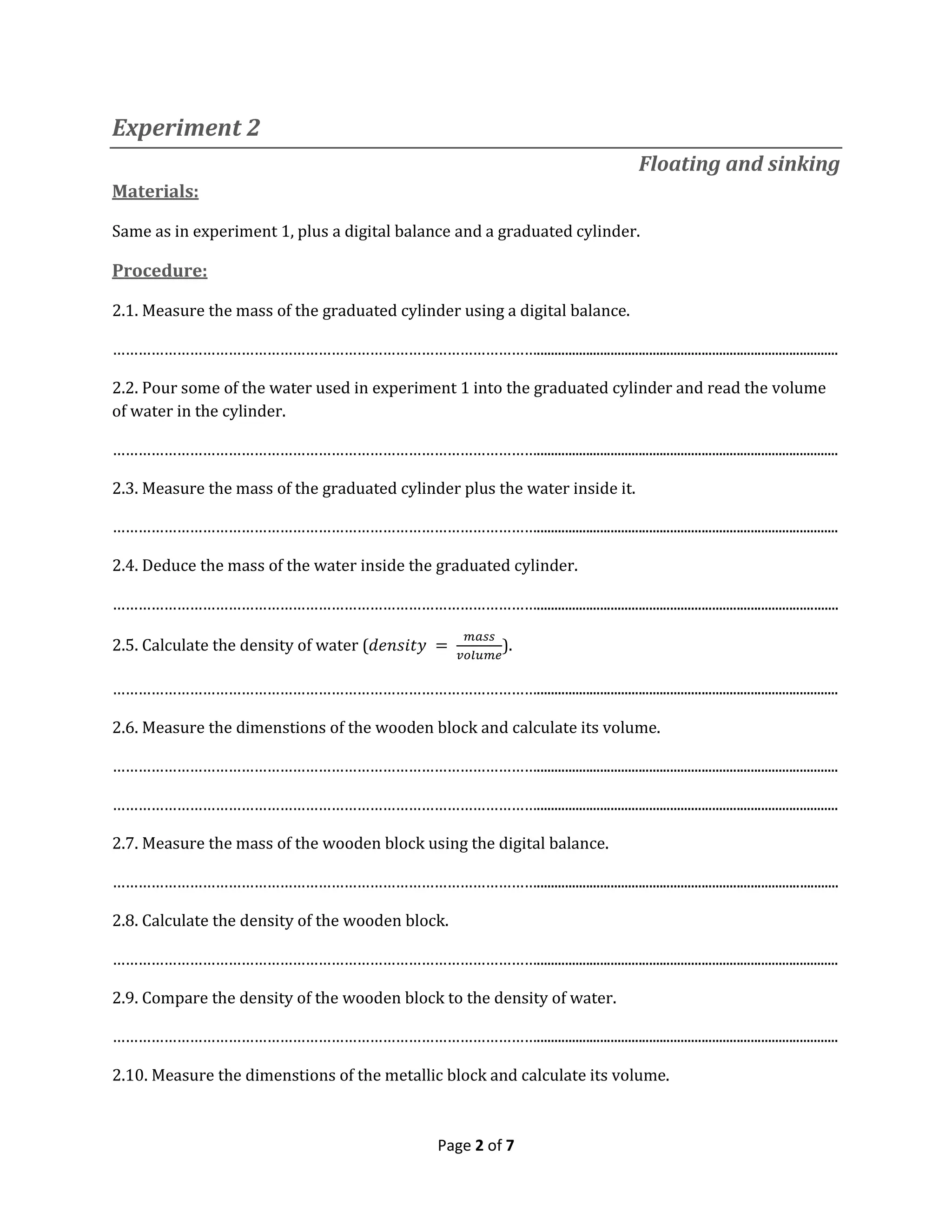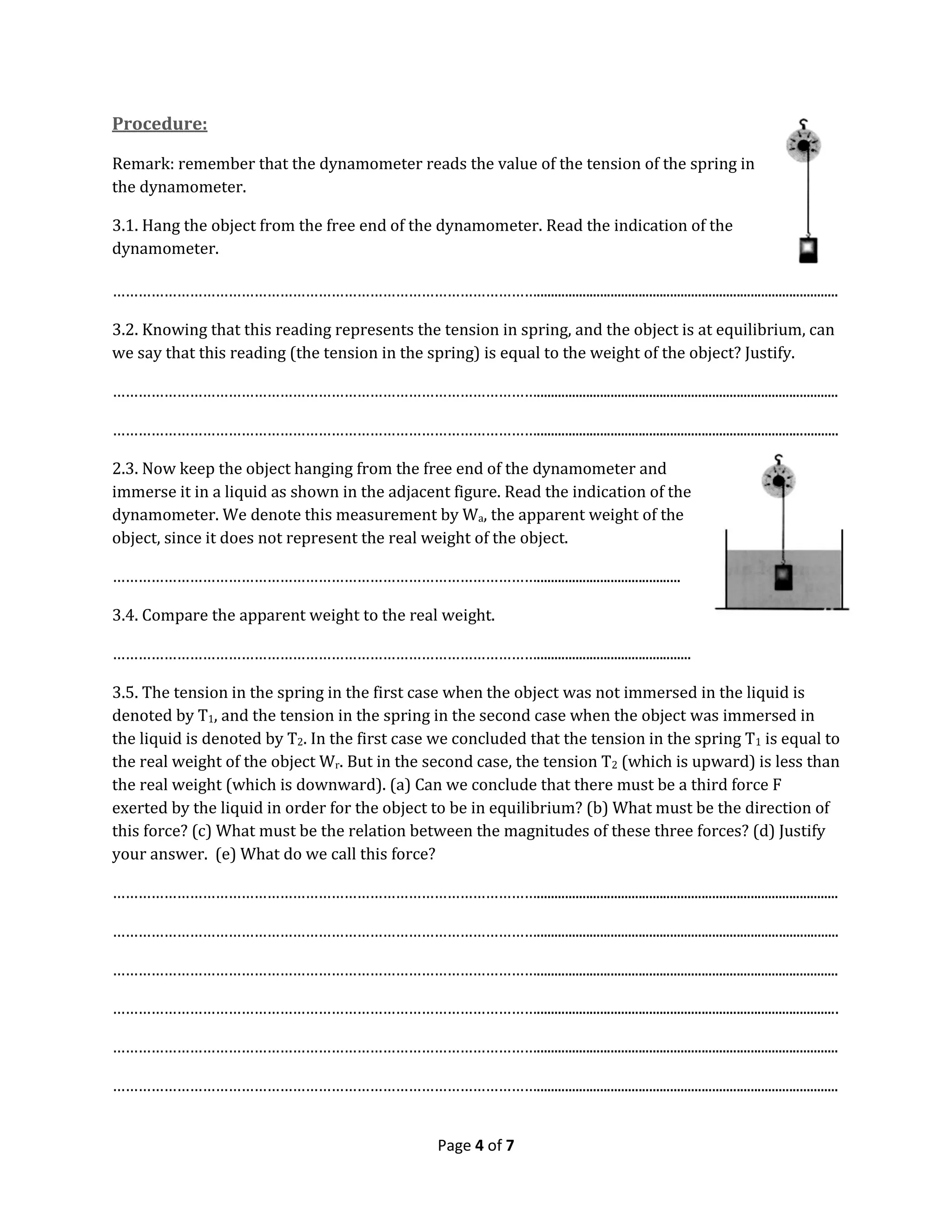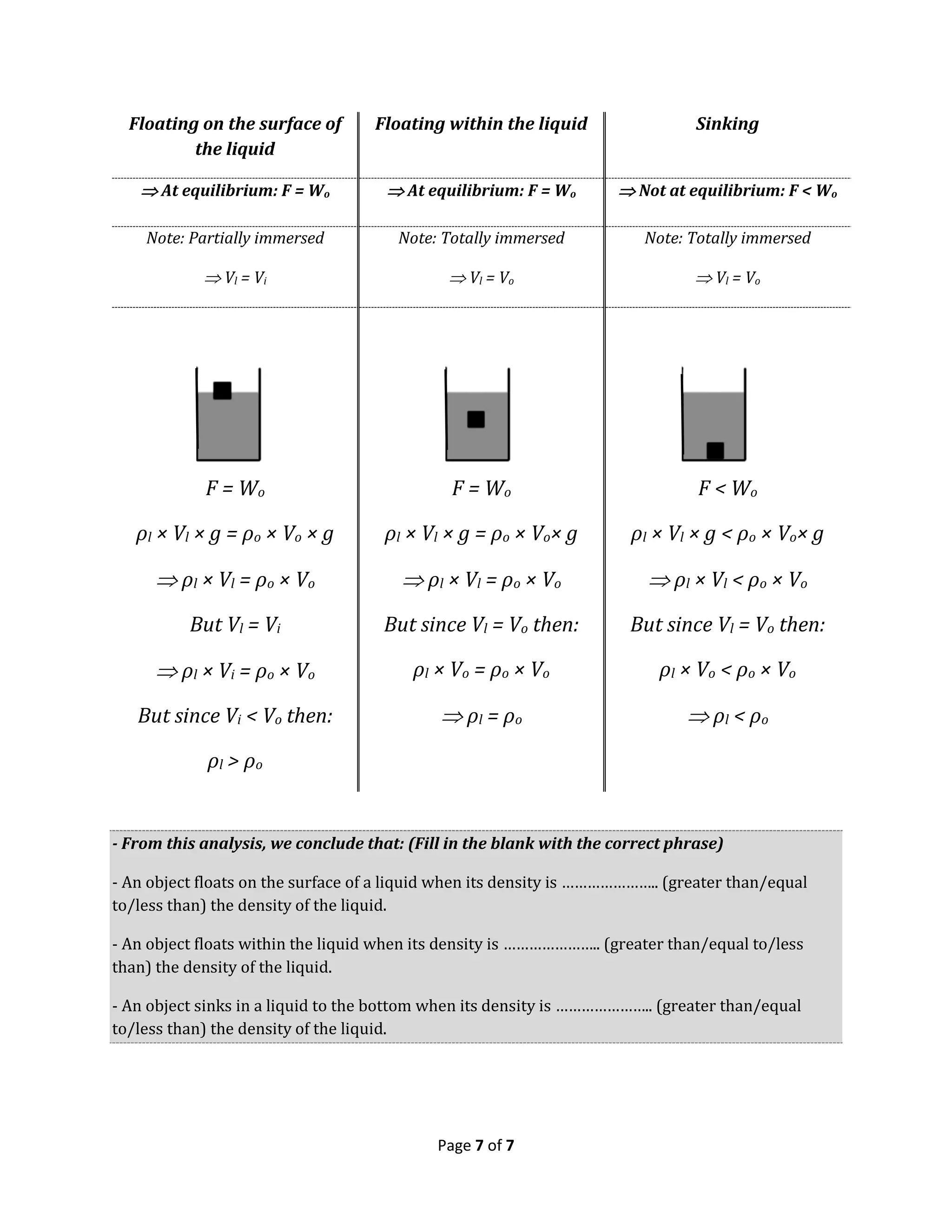This document outlines a physics lab worksheet focused on Archimedes’ principle and experiments related to buoyancy, density, and forces in liquids. It includes experimental procedures for determining the existence of upthrust, the conditions for floating or sinking of objects based on their density relative to a liquid, and the relationship between real and apparent weight. The experiments involve using various materials to illustrate concepts such as upthrust, density calculations, and the weight of displaced liquid.
![Page 1 of 7
Physics Lab
worksheet# 11 Archimedes’ upthrust
Name: Teacher: Farid Minawi
Experiment 1
Existence of upthrust force in liquids
Materials:
- A wooden rectangular or square block.
- A metallic rectangular or square block.
- A beaker containing water.
Procedure:
1.1. Immerse the woodent block in water, then release it. Does it sink or float?
…………………………………………………………………………………………………………………………………
1.2. Immerse metallic block in water, then release it. Does the object sink or float?
…………………………………………………………………………………………………………………………………
1.3. What is forcing the floating object to go up?
………………………………………………………………………………………………...........................................................................
1.4. Can we conclude that there is a push force exerted by the liquid? What is the direction of this
force?
………………………………………………………………………………………………...........................................................................
1.5. From this experiment, we conclude that: (choose the correct statement or statements)
[ ] In a certain liquid, some objects sink and some float.
[ ] A liquid exerts on objects within it a thrust (push) force downwards, then we call this force
down-thrust.
[ ] A liquid exerts on objects within it a thrust (push) force upwards, then we call this force up-
thrust.](https://image.slidesharecdn.com/physicslabworksheet-archimedesupthrust-190416195837/75/Physics-lab-worksheet-Archimedes-upthrust-1-2048.jpg)

![Page 3 of 7
………………………………………………………………………………………......................................................................................
………………………………………………………………………………………......................................................................................
2.11. Measure the mass of the metallic block using the digital balance.
………………………………………………………………………………………......................................................................................
2.12. Calculate the density of the metallic block.
………………………………………………………………………………………......................................................................................
2.13. Compare the density of the metallic block to the density of water.
………………………………………………………………………………………......................................................................................
2.14. Can you conclude a condition for the object to float on the surface of a liquid?
………………………………………………………………………………………......................................................................................
2.15. Can you conclude a condition for the object to sink in a liquid?
………………………………………………………………………………………......................................................................................
- You can repeat this experiment with blocks of other substances and different liquid and bolster
your conclusion.
2.16. From this experiment, we conclude that: (choose the correct statement or statements)
[ ] A body floats on the surface of a liquid if its density is greater than the density of the liquid
[ ] A body floats on the surface of a liquid if its density is less than the density of the liquid
[ ] A body sinks in a liquid if its density is less than the density of the liquid
[ ] A body sinks in a liquid if its density is greater than the density of the liquid
Experiment 3
Real weight and apparent weight
Materials:
- An object that sinks in water
- A dynamometer (spring balance)
- A beaker containing liquid.](https://image.slidesharecdn.com/physicslabworksheet-archimedesupthrust-190416195837/75/Physics-lab-worksheet-Archimedes-upthrust-3-2048.jpg)

![Page 5 of 7
3.6. From this experiment, we conclude that: (choose the correct statement or statements)
[ ] Real weight = upthrust – apparent weight (Wr = F – Wa)
[ ] Upthrust = real weight – apparent weight (F = Wr – Wa)
[ ] Real weight = apparent weight + upthrust (Wr = Wa +F)
Experiment 4
Displaced liquid
Materials:
- An object that sinks in water
- A dynamometer (spring balance)
- A beaker with a tap
- A small beaker (to collect the overflowing liquid).
- Digital balance
Procedure:
4.1. Measure the real weight of the object in air (Wr)
………………………………………………………………………………………......................................................................................
- Fill the beaker with liquid to the level of the tap.
4.2. Measure the weight of the empty small beaker using the digital balance.
………………………………………………………………………………………......................................................................................
4.3. Put the small beacker under the tap to collect the overflowing liquid and
measure the apparent weight of the object in the liquid (Wa) as shown in the
adjacent figure.
………………………………………………………………………………………................................................
4.4. Calculate Wr – Wa.
………………………………………………………………………………………................................................
4.5. Measure the weight of the displaced liquid (Wl) by measuring the weight of the small beaker
with the displaced liquid in it using the digital balance and then subtracting the weight of the empty
small.](https://image.slidesharecdn.com/physicslabworksheet-archimedesupthrust-190416195837/75/Physics-lab-worksheet-Archimedes-upthrust-5-2048.jpg)
![Page 6 of 7
………………………………………………………………………………………......................................................................................
4.6. Compare Wl to (Wr – Wa).
………………………………………………………………………………………......................................................................................
4.7. Knowing that F = Wr – Wa, conclude the relation between the upthrust and the weight of the
displaced liquid.
………………………………………………………………………………………......................................................................................
4.8. From this experiment, we conclude that: (choose the correct statement or statements)
[ ] The weight of the displaced liquid is equal to difference between the real weight and apparent
weight (Wl = Wr – Wa)
[ ] The weight of the displaced liquid is equal to the weight of the beaker.
[ ] The weight of the displaced liquid is equal to the upthrust (Wl = F)
Analysis
Floating and sinking
- In this analysis, we are going to derive the result of experiment 2 mathematically.
- Remember the relation between density ρ of an object, its mass m and its volume:
𝜌 =
𝑚
𝑉
⇒ 𝑚 = 𝜌 × 𝑉
- So the weight Wo of the object:
𝑊𝑜 = 𝑚 𝑜 × 𝑔 = 𝜌 𝑜 × 𝑉𝑜 × 𝑔
Where mo is the mass of the object, o the density of the object and Vo the volume of the object.
- Also, the upthrust is equal to the weight of the displaced liquid:
𝐹 = 𝑊𝑙 = 𝑚𝑙 × 𝑔 = 𝜌𝑙 × 𝑉𝑙 × 𝑔
Where ml is the mass of the displaced liquid, l the density of the liquid and Vl the volume of the
displaced liquid.
- Also notice that the volume of the displaced liquid Vl is equal to the total volume of the object Vo
when the object is totally immersed, and is equal to the volume of the immersed part Vi of the object
when the object is partially immersed.](https://image.slidesharecdn.com/physicslabworksheet-archimedesupthrust-190416195837/75/Physics-lab-worksheet-Archimedes-upthrust-6-2048.jpg)
